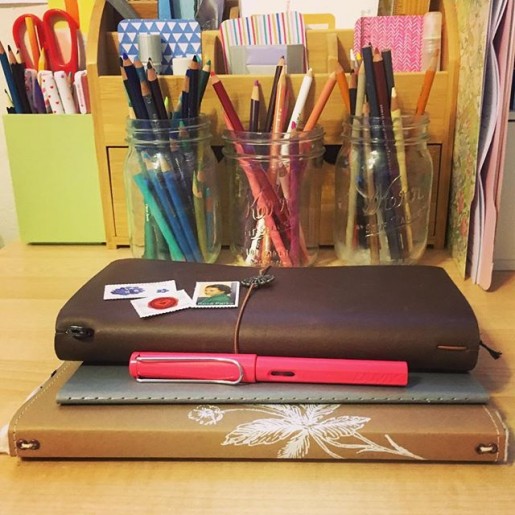
My everyday favorites. After a year of experimenting, I’ve got my system figured out. Top to bottom:
• Midori Travelers Notebook for my monthly calendar, weekly journal, and a scribble notebook;
• Moleskine Cahier for daily to-lists (bullet journal);
• Wild Simplicity Daybook for homeschooling notes and records (including our weekly Shakespeare lines—we learn monologues two lines at a time); and
• the Lamy Safari fountain pen my family gave me for my birthday. (LOVE.) (That’s an Amazon affiliate link but if you’re buying pens in the U.S., you should order from the nice people at Goulet Pen Company. Their instructional videos are invaluable, their customer service is top notch, and they offer inexpensive ink samples so you can try out all sorts of gorgeous colors. And that is not an affiliate link. I’m just a happy customer.)
I still keep the family appointments on Google Calendar, but I enjoy writing everything out in the TN monthly calendar (#017) as well. I use the horizontal weekly TN insert (#019) for chronicling the day after it happens—just a few notes about highlights. For the last several months I’ve used a blank TN insert (#003) for my bullet journal but came to realize I need a separate space for scrawling, sketching, doodling, working things out on paper. If I do that in the bullet, things get messy. WAY messy. So I’ve gone back to my old (cheaper) Moleskine grids for task lists.
The Midori travels with me everywhere; the bullet journal lives on my desk where I do most of my work; and the Daybook has a home in a basket by my rocking chair in the living room.
I’m laughing at how complicated this must seem if you aren’t a pen-and-paper fanatic…but I juggle a lot of roles (and kids) and I find having different paper spaces helps me keep things straight.
More nitty gritty:
I also have a kraft folder (#020) in my Midori to tuck ephemera and snail-mail supplies into. Since I started carrying notecards and stamps around, I’ve gotten much more prompt with my thank-you notes.
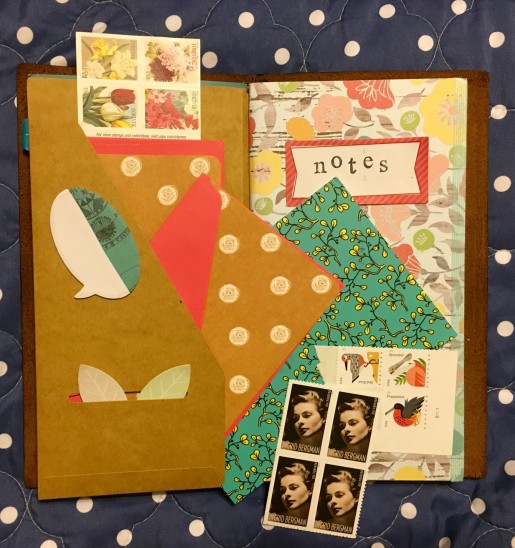
• I love the feel of Prismacolor colored pencils on the paper Lesley Austin uses in the Wild Simplicity Daybook. I’m sure I’ve raved about this before—the lovely creamy pencil on this recycled paper with just the right amount of tooth.
• Prismacolor pencils also delight me in the bullet journal: I like ’em for filling in my checkboxes.
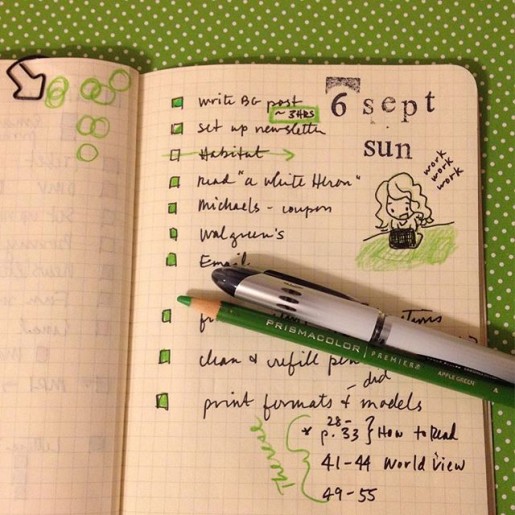
• This pic, which I’ve shared here before, shows my favorite way to organize a task list: to-do items on the right, and the verso is for related notes and numbers. I also keep a running “Nag List” on a sticky note that travels from spread to spread. It’s for important tasks that I might not get done today but I gotta deal with soon—like finishing my taxes or booking a doctor appointment. I consult it each evening when making out my bullet list for the next day.
• Sometimes I’ll tuck another insert into the Midori to be used for a specific purpose. For example, I keep a log of incoming and outgoing snail mail. I don’t like a superfat Midori, though, so more often that insert lives in my stationery pouch.
• As I mentioned, I do a lot of casual sketching in my blank Midori insert. I find I’m often more comfortable there than in my proper sketchbook, because it feels more casual. But I do have a couple of sketchbooks going and I try to work in at least one of them daily. One is a spiral-bound 7×10 Canson Mixed Media pad, which gets lukewarm reviews from real artists but I quite like its toothy paper—not to mention its price point when Michael’s has a good sale + coupon combo. You have to watch for it, but now and then they’ll give you a 20% off including sale items coupon during a buy-one-get-one-free sketchbook sale. My other sketchbook is a Moleskine Art Plus, and it’s…okay? I love its size and shape (fits nicely in my bag), but the paper is too smooth for my liking. I much prefer the feel of Moleskine’s watercolor sketchbook—a lovely texture to that paper. But so far I’ve mostly just used that for color charts.
• For sketching pens, I like Sakura Pigma Microns or my Pilot Metropolitan fountain pen (check out all the groovy colors at Goulet Pens) with Platinum Carbon ink, which is waterproof so it plays nice under watercolors. However, lately I’ve come to realize that what I enjoy most of all is sketching in pencil. I love the look of black or brown ink drawings, and most of the sketchbook artists I admire work directly in ink, but I really love the way a pencil feels on the paper. I keep hitting that point over and over, don’t I—the tactile experience matters more to me than how it looks.
Ha, this got long! Would you believe it was just going to be a quick copy-paste of something I tossed on Instagram today?
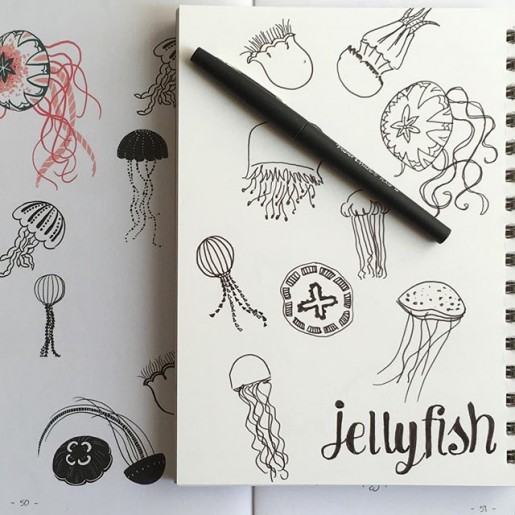
It started, I think, with my commitment to a daily sketching habit in the fall of 2014. By last January, the habit was firmly established, and I only missed a handful of days all year. January is also when I started taking “kourses” at Sketchbook Skool—which exposed me to not just the lessons and work of accomplished artists, but also to their media of choice. Which is to say: they have firm opinions about pens, making them my kind of people.
Putting pen to paper in my sketchbook reminded me how much I love that feeling. Now, I have never enjoyed doing large amounts of handwriting—I can’t write my books longhand, for example. My wrist aches after a couple of pages. But I love penmanship: other people’s, mainly. My handwriting is changeable and seldom neat. I never managed to commit to one way of shaping letters, so I wind up with different kinds of I and r and k all in one line. Last night I was numbering pages in a new bullet journal and realized that some of my 4s were the pointy kind and some were not. Happens all the time. I like change, y’all.

Anyway—I can’t write volumes by hand all at once, but I adore the feeling of a good pen on the right kind of paper. Experimenting with various pens (Pigma Micron, Le Pen, Pilot Metropolitan, Lamy Joy with 1.1 nib) reminded me how much I love analogue notetaking. So while I still find apps like Workflowy useful for tracking particular kinds of tasks, in the past few months I have shifted almost entirely to written notekeeping.
Notes on paper
Bullet journaling works very well for me. I’ve always kept a notebook as an idea and memory catch-all: phone call records, tasks completed, shopping lists, story ideas, doodles—it all winds up in the notebook in a giant jumble. Adding a bullet-journal-style index and page numbers was a revelation: now I can have my hodgepodge but find things later. Perfect.
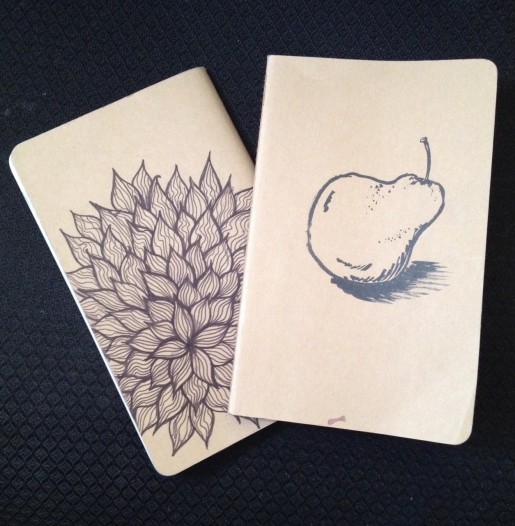
For the first part of this year I used kraft-brown Moleskine Cahiers. They’re just the right size for tucking in my bag, they’re sturdy enough to handle the beating I give them, and they fill up in a month or two which means the continual fresh start I love. Then, in August, a glorious friend surprised me with a Midori Traveler’s Notebook. It was love at first sniff. I mean, I. JUST. ADORE. THIS. THING.
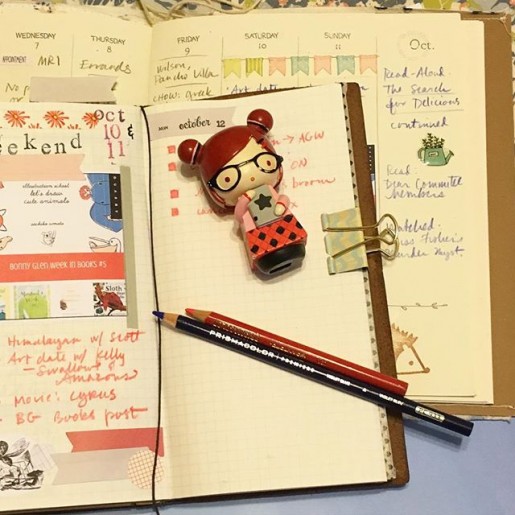
A traveler’s notebook, if you don’t know, involves a cover (usually leather, sometimes cloth or vinyl) that has a sturdy elastic cord or two strung through the spine. You slip a paper notebook under the cord to hold it in place. Then you can use additional bands to hold other inserts—various types of notebooks, folders, calendars, even plastic credit-card sleeves or zipper pouches.
My Midori set-up
After playing with my Midori for a month or two, I settled into the configuration that works best for me: a weekly calendar insert, a grid notebook, and a kraft folder that holds stickers, postage stamps, notepaper, and such. I keep a monthly calendar, too, but I don’t need to carry the whole year around with me so I have begun photocopying (and shrinking a bit) the current month and clipping that to my weekly page.

The blank grid insert is my bullet journal/idea repository/casual sketchbook, replacing the Moleskine Cahier. I number the pages and use the first page as an index, just as before. I like big fat checkboxes for my task lists, which I fill in with Prismacolor pencil as tasks are completed. Color is my happy place.  I also like to paste in ephemera and sometimes embellish with stamps, doodles, or washi tape. Basically, these inserts become collages of all the things that occupy my days and my mind. I seem to do a fair amount of sketching in them, too, even though I have an actual sketchbook for that purpose—I work in the real sketchbook daily but the TN grid insert is a low-pressure place to experiment, and I always have it with me.
I also like to paste in ephemera and sometimes embellish with stamps, doodles, or washi tape. Basically, these inserts become collages of all the things that occupy my days and my mind. I seem to do a fair amount of sketching in them, too, even though I have an actual sketchbook for that purpose—I work in the real sketchbook daily but the TN grid insert is a low-pressure place to experiment, and I always have it with me.
Thanks to Lesley Austin’s beautiful Wild Simplicity Daybook designs, I discovered that a week-on-two-pages spread is an excellent space for me to do some chronicling. I’ve posted before about how I use the Daybook for recording homeschooling and housekeeping notes. I really like having a separate space (and such a beautiful one) for those things. I wear so many hats, and I need ways to keep my roles sorted. The Daybook (visible under my Midori in a photo above), like all of Lesley’s paper goods, conveys a sense of peace and serenity, and so it has become a really nourishing space for me to jot down my notes about what the kids read, did, said. I always feel so happy when I open that book.
Taking a cue from that experience, I decided to try the Midori week-on-two-pages for my TN. The version I selected (Refill #19) has the week in seven horizontal boxes on the left page, and a grid page for notes on the right. I use Google Calendar for our family appointments and schedules, so a couple of times a week I open G-Cal and add any new appointments to the Midori insert. At the end of each day, I create an entry on the weekly calendar page, filling it with notes about what happened that day. It isn’t a to-do list, it’s more like a diary. Not what needs to be done (that’s what the bullet journal is for), but what I actually did. The facing page fills up with quotes, ephemera, drawings, and notes on things I’ve read or watched.
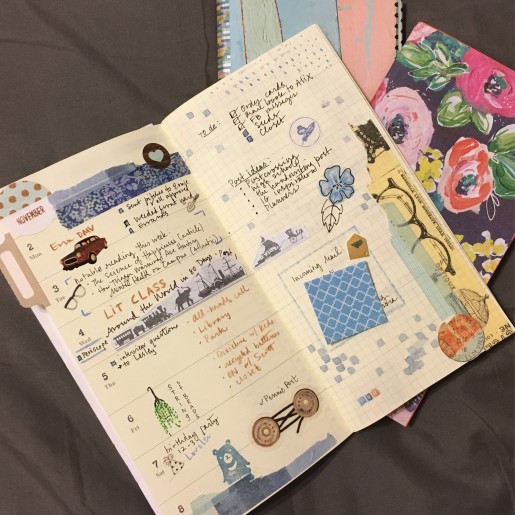
Since these pages serve as a kind of journal, I like to decorate them with washi, drawings, and watercolors. I wind up doing the ornamenting mostly on weekends. Often, I’ll start the week with two or three colors of washi in front of me, and that will set the tone for my week. This daily decorating is relaxing, it takes only moments, and I enjoy paging back through previous weeks.
So those are the two main TN inserts I carry around: the weekly calendar for journaling (more or less), and the grid notebook (Refill #2) for everything else. Those two inserts plus the kraft folder (Refill #20) make the Midori as fat as I like it to get. I could easily come up with uses for half a dozen more inserts (the TN’s capacity for letting you compartmentalize is its genius), but I found that I really prefer a non-chunky Midori.
However! I did decide to devote a single insert to all medical and health-insurance-related notes, and this has been one of my best moves ever. Instead of having those notes intermingled with everything else, they live in their own space now, with a list of phone numbers on the first page. I can tuck THAT insert into the Midori when we’re heading to an appointment. It’s perfect.
NEED MOAR PAPER
All this notebooking served to increase the satisfaction I was finding in putting pen to paper. And I found I was thinking about handwriting a lot. My little goddaughter sent me a thank-you note, and her mother’s handwriting on the envelope—the gorgeous, familiar handwriting that graced pages and pages of letters in the years after college when Krissy and I wrote to each other constantly—gave me a little jolt of joy and nostalgia. I hadn’t seen her writing in a while, and I missed it. I told her (via text, naturally) how happy I’d been to see her writing, and she said the same thing had happened to her when she saw my writing on the package I’d sent her daughter.
Shortly after that, I read that Atlantic article that was making the rounds about how the ballpoint pen killed cursive. Fascinating stuff, but the bit that grabbed me was this: “In his history of handwriting, The Missing Ink, the author Philip Hensher recalls the moment he realized that he had no idea what his good friend’s handwriting looked like. ‘It never struck me as strange before… We could have gone on like this forever, hardly noticing that we had no need of handwriting anymore.'”
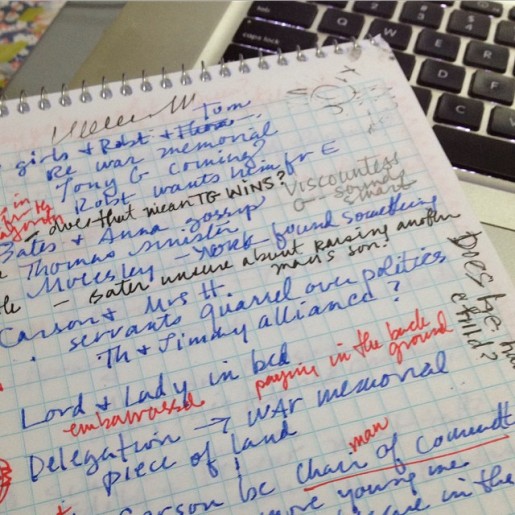
He had no idea what his good friend’s handwriting looked like. I miss handwriting, I thought. The distinct and beloved scripts of my old friends flashed before my eyes. I’d know those hands anywhere, could pick them out of any penmanship lineup. My kids probably won’t experience that. Jane has friends on the other side of the country she talks to via electronic means every single day, but they probably don’t know each other’s handwriting. I have plenty of friends myself whose writing I’ve never seen. If we met after 1995, chances are I’ve seen your handwriting seldom or never. (Tanita! What’s your writing like?)
Channeling my inner Jane Austen
The handwriting epiphany spurred me to the next phase of my analogue journey: I started writing letters again. Like, by hand. I have penpals in Denmark, France, Austria, and England, as well as various friends across the U.S.
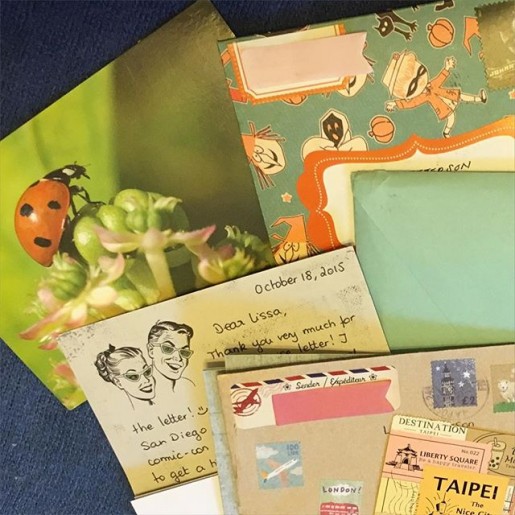
I’m amused and a little baffled that for so many years I thought of letters owing replies as a kind of guilt-ridden chore—I always took forever to answer, always had them nagging in the back of my mind. Because the truth is: snail mail is the cheapest fun around. Sure, they’re slower to write than email; slower to arrive than a Facebook message. But that’s part of the charm: the slowing down, the taking time. Just as many of us have (re)discovered the joys of slow reading in the past couple of years, I have found satisfaction in…what to call it? Not slow writing, really, because part of the point is that instead of waiting months or even (gulp) years to answer a letter, I now try to reply within three weeks; I guess what I’m enjoying isn’t about speed (or lack of it) after all. It’s about a tactile experience. The skritch of a fountain pen on flecked paper. The careful selection of stamps. The smoothing-out of a bit of washi tape across a seal. The rustle of envelopes as they slide into the box, slumbering before their journey to places I’ll never go.
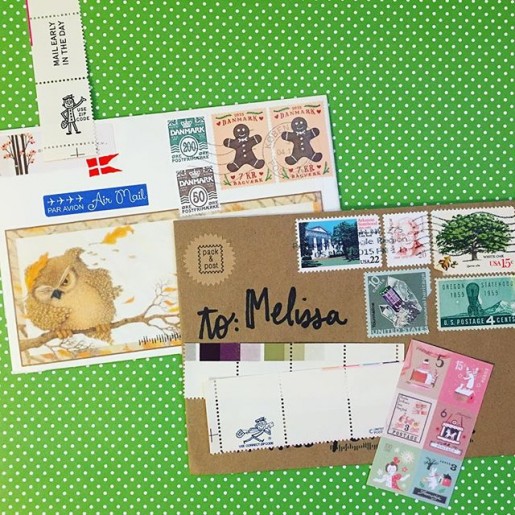
And best of all: the incoming letters. Foreign stamps, unfamiliar scripts, universal experiences. Beautifully decorated, many of them—it’s like getting mail from Griffin and Sabine. This one written at a café in Vienna; that one at a Starbucks in Portland. Kaleidoscopic glimpses of a life gradually resolving into a picture. We talk about things we could easily tell via email, but we’ve decided to let these stories take the scenic route. Some of them never arrive, or show up months later, ragged and stained. This only makes us love them more.
I’m writing to say I’ll write soon
A piece of the experience that affords me much merriment is the impulse, whenever a letter arrives, to hurry to Facebook and ping the friend who sent it. “Got your letter! Will reply soon,” I’ll write, and “Yay, can’t wait!” she’ll ping back. Never mind that the letter asks questions which could be more immediately answered via any of a dozen digital platforms. The answers will keep. Come Saturday afternoon, I’ll settle in with my cocoa, my envelopes, my wonderful new pink Lamy Safari that I got for my birthday. Which paper—the whimsical or the lovely? The fern stamps, or the Ingrid Bergmans? I’m almost out of globals, and the post office won’t have the new ones for a while. But have you seen them, the moons? I’m already imagining them on dark blue envelopes…
Our digital and analogue worlds will forever be intertwined, I believe. We’ll snap photos of our beautiful incoming mail to share on Instagram, hashtagged so our kindred spirits can find and enjoy it. We’ll trade addresses on Facebook. We’ll email to find out if that letter ever arrived. We’ll scour Etsy for traveler’s notebook inserts and stock up on ink at Goulet Pens. We’ll sign up for swaps on websites, and then anxiously check tracking to see when packages might arrive. We’ll reblog Tumblr articles about clever ways to hack a bullet journal. We’ll watch Youtube videos about how to set up a Midori and we’ll tap the heart button a zillion times during an unboxing on Periscope. We’ll link to photos of new USPS stamp releases in our blog posts. 
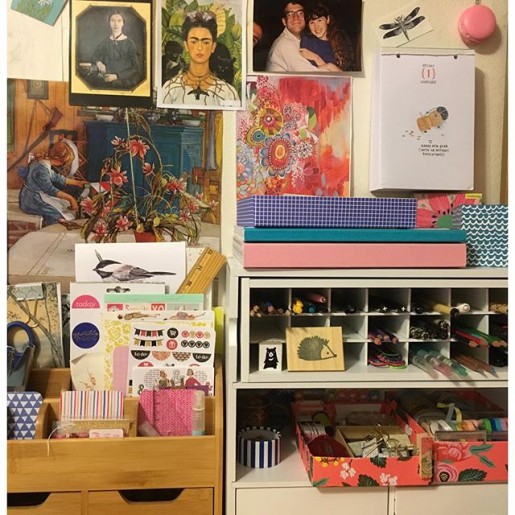
My blog, though, is perhaps the thing that suffered this past year as my attention shifted to paper and ink. I found that when I had a few quiet moments, I was more apt to want to spend them sketching or writing a letter than blogging. After ten years of a steady blog habit, that was a bit of a surprise. In January, this blog will be eleven years old. I’ve successfully figured out how to integrate my analogue and digital calendar-keeping and task-tracking, but it did take a little while for the pieces to settle into place. I expect the same will happen with blogging.
Happy New Year, friends!
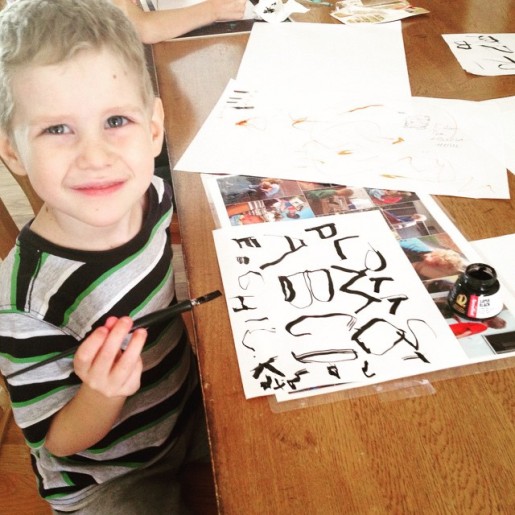
About once a week I bring my fountain pens to the kitchen tape for refilling. My reason for making this rather quick, benign chore a public affair is to take advantage of the great parenting truism: If you do it, they will copy. Huck isn’t the kind of kid who would be too keen on formal handwriting practice (does that kind of kid even exist?), but if I get busy with some nifty writing utensil, he’s at my side in a flash, begging for a turn.
Fountain pens are awesome enough, but dip pens? There’s nothing better. A bottle of ink, a nib with just the right amount of skritch…there’s a happy kid. I didn’t suggest the alphabet practice; he filled up the page as he chose.
That’s my beloved metal brush pen he’s holding, the $1.49 treasure acquired during my surprise trip to the art supply store on Mother’s Day. (The plastic Speedball pen holder was another buck fifty. We live large.)
(That’s an Amazon link to show you what it looks like, but as you can see, you’re much better off buying local for this one. That’s some markup, eh?)
I tumbled to the metal brush pen (aka my new best friend) in Jonathan Twingley’s rather amazing class at Sketchbook Skool. It was swoon at first site. You get a broad line from the flat nib, or you can turn it on its side for a fine line. It’s on the messy side—likes to spatter ink if you change direction midstroke—but for me that’s part of the appeal. I use it when I’m in the mood for rough, bold lines and a bit of ink spray. Jonathan Twingley likes to fill pages and pages with large drawings and then cut out selected images and collage them together into a new piece of art—really quite magical to behold him at work.
And this post offers a quite detailed look at what a steel brush nib can do.
We also have a pair of glass dip pens that my parents gave me years ago with more typical pointed nibs. You can see Huck’s page of orange squiggles on the table. I know somewhere in my archives I’ve talked about the magical powers of colored chalk and a little slate, or a whiteboard and dry erase markers, for transforming otherwise dull writing into fun. Dip pens are the same principle times a hundred.
Here's a little review for those of you who are considering trying out fountain pens but don't want to spend much: an OK pen for under a fiver.
I needed a new cheap fountain pen to write with - I always write with fountain pens, it helps my handwriting. Ballpoint pens tend to run away and scrawl when I use them. I don't like writing with my sketching pens, they aren't designed to move that quickly.
I wanted a pen that uses standard cartridges - normally I like writing with LAMY pens, but the cartridges are expensive, and although converters are available I don't want to carry a pot of ink around to refill it.
I had to climb up a ladder at the stationer's to get to this one, they put it out of reach, probably because it's so very cheap. Anyway, it's surprisingly nice to use: it's got a chunky grip, so it would be good for school children to use and it won't give you writing cramp as quickly as a slim pen.
It's got a very pleasing mechanism that grabs the cartridge and clicks it into place, so no accidental messy unscrewing.
You can write quickly with it, it's not the smoothest but it doesn't scratch - a good everyday writing pen.
If you want a fine line to scribble with, you can turn it upside down - that means that the grip isn't as grippy, but it's a nice line, good enough for a quick sketch when you didn't take any fancier equipment along.
American Gods will be going live to read on the 28th of February.
Some interesting auditory illusions over at
http://www.newscientist.com/article/dn13355-music-special-five-great-auditory-illusions-.htmlalthough I didn't quite understand the opening of the article. Apparently the bit on Lady Madonna where it sounds like the Beatles are singing into their hands is not a saxophone, but I don't know anyone who thought it was.
And all the various and sundry comments I've made in this blog about the writing of
The Graveyard Book are gathered together at
http://quotableneil.blogspot.com/2008/02/brief-or-not-so-brief-history-of.html Neil,
A few weeks back you posted that you were thinking about going to Tulsa this summer. Are you going to do any public appearances there? And if so, when? I am excited to hear that you finished The Graveyard Book. Looking forward to reading it!
-Megan
I'll be in Tulsa on June the 28th 2008, and I'll be doing a public event there -- details to follow.
I'll also going to be teaching a week at Clarion -- more properly The Clarion Science Fiction & Fantasy Writers' Workshop at UCSD -- this July (rather nervously, I suspect, as I've never taught before, and have no idea if I'll be any good at it). But you've got people like Geoff Ryman and Kelly Link and Nalo Hopkinson who know what they're doing teaching as well, so even if I'm rubbish it'll be okay.(You have four days left to apply for Clarion, if you've been putting it off.)
Hey Mr. Gaiman!
The University East Anglia have this fairly-famous and pretty reputable Creative Writing course, which was set up by Malcolm Bradbury. I have the option of attending this course, but being not being a British citizen, it requires obscene amounts of money. So my question to you is whether or not you think a workshop of that sort would be worth the investment in time and money. And please, this isn't an 'oh-my-god-if-neil-gaiman-says-it's-good-then-i-must-go-come-hell-or-herpes' (or vice versa) situation, it's just that, other than Malcolm Bradbury, I haven't read the work of any of the authors that came out of that sort of course (a similar one is taught at Warwick). And you're apparently rather big in the whole 'writing' business, so perhaps you might have an opinion or two to share.
So is a course like that, or lack thereof, going to make-or-break an aspiring writer?
Wishing you well,
Liam KrugerNo, of course not. (For proof, look at the careers of the many writers who have not attended Creative Writing Courses at the University of East Anglia. It's most of the writers you can think of. Statistically, it's pretty much all of them. They did fine, didn't they?)
I've never done any Creative Writing courses, but someone who had wrote in back in
http://journal.neilgaiman.com/2004/11/probably-not-gold-watch.asp and talked about them.
I thought you might like this interview with the God of Fountain Pens:
http://blog.makezine.com/archive/2008/02/interview_with_the_god_of.html?CMP=OTC-0D6B48984890
I'm probably not the only one to send you this link, but I couldn't take that chance ;-)How cool! Here in the US we have Richard Binder of
http://www.richardspens.com/ My Christmas present from Henry Selick was a Pelikan pen which Richard had turned into a flexinib, and which I'm waiting for the right thing to come along so i can write a story with it.
Dear Neil, I read with interest that there is a character called Silas in your latest book. I named my son Silas at almost exactly the moment the Da Vinci code came out, and found upon reading it that my son now shared a name with a hulking, blond, albino assassin monk. I am hoping your Silas is of a more child friendly persuasion? I was going to read the Graveyard Book to my Silas if so! Gaby
Silas is our hero's guardian and I'm a huge fan of his.
Hi Neil;
I was wondering, now that The Graveyard Book is done and you have some noodling and minor fine tuning to do, is it smooth sailing to the printers? Or does a book at this stage of it's life have to go through a painful publishing bureaucracy where everyone gives their two cents? Looking forward to the new book.
-Brian
I've given it to my editors at Harpers in the US and Bloomsbury in the UK and I'm looking forward to finding out what they have to say. I've sent it to friends and I'm looking forward to finding out what
they have to say. Any comments that strike me as wise or sensible get acted on, any that don't, don't.
Mostly I want it to be the best book it can possibly be. There isn't any bureaucracy. I think there's a general feeling that we're not going to go with the cover of
The Graveyard Book that I posted in
http://journal.neilgaiman.com/2008/01/for-curious.htmlthough, because it looks too much like a book that's intended only for young readers, and now it's finished I think we're all realising that this is as much a book for adults as it's a book for younger readers, so I think Dave is going to play around with some different cover ideas...
Read the rest of this post
 I'm as excited as the next guy about the iPhone--Apple's new super-cell that is coming out in June--but CNET News just reported how the iPhone led some new media journalists down a rabbit hole last week.
I'm as excited as the next guy about the iPhone--Apple's new super-cell that is coming out in June--but CNET News just reported how the iPhone led some new media journalists down a rabbit hole last week.
In the article, CNET News crowed about their competition's mistake. The website Engadget had published a false memo about the iPhone production schedule.
Reportedly, the stock price at Apple actually dropped with the fake leak--leading CNET to dub the case "Applegate."
Every time this kind of high-speed publishing scandal rocks the blogosphere, I like to offer a quote from the story, "Penny-A-Worder" by Cornell Woolrich--a reflection on the self-destructive joy of writing for the vicious pulp fiction industry in the 1930's.
"The story flowed like a torrent. The margin bell chimed almost staccato, the roller turned with almost piston-like continuity, the pages sprang up almost like blobs of batter from a pancake skillet. The beer kept rising in the glass and, contradictorily, steadily falling lower. The cigarettes gave up their ghosts, long thing gray ghosts, in good cause; the mortality rate was terrible."
Right now, the only successful writers are the ones who produce manic quantities of opinionated posts on the web. I'm scared that ten years from now, thousands of frenzied writers will be publishing millions of disposable blog posts, all of us earning Depression-era salaries.
The lesson is simple for us reporters writing at the speed of blog: don't let this new news cycle spoil your instincts.











 I also like to paste in ephemera and sometimes embellish with stamps, doodles, or washi tape. Basically, these inserts become collages of all the things that occupy my days and my mind. I seem to do a fair amount of sketching in them, too, even though I have an actual sketchbook for that purpose—I work in the real sketchbook daily but the TN grid insert is a low-pressure place to experiment, and I always have it with me.
I also like to paste in ephemera and sometimes embellish with stamps, doodles, or washi tape. Basically, these inserts become collages of all the things that occupy my days and my mind. I seem to do a fair amount of sketching in them, too, even though I have an actual sketchbook for that purpose—I work in the real sketchbook daily but the TN grid insert is a low-pressure place to experiment, and I always have it with me.


















